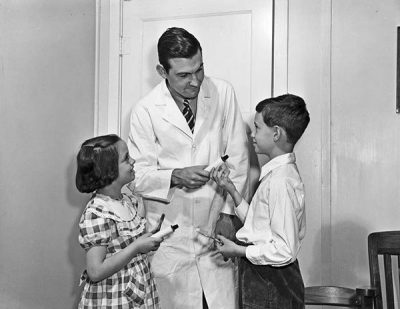FOR IMMEDIATE RELEASE
WASHINGTON, April 4, 2024 — Until the mid-20th century, toothpastes were little more than pleasant-smelling abrasives. But in 1955, the introduction of Crest toothpaste brought fluoride chemistry to the fight against tooth decay, launching a new era in dental care. The American Chemical Society (ACS) honored the development of Crest with the National Historic Chemical Landmark designation during a ceremony at Procter & Gamble (P&G) in Cincinnati, Ohio, on April 3. And it will hold another ceremony to honor Crest at Indiana University (IU) in Bloomington on April 4.

Crest toothpaste was developed through a partnership between IU and P&G. “Following Crest’s introduction, fluoride toothpastes have improved the dental health of millions worldwide by putting powerful cavity-fighting chemistry in the hands of consumers. And that is a legacy to be proud of,” says ACS President Mary K. Carroll, who is an IU alum and an award-winning chemistry professor at Union College. “We are excited to honor IU and P&G for their transformative work, which affirms the power of academic-industrial partnerships.”
The history of toothpaste extends back to ancient times in Egypt. Concoctions to clean teeth included abrasive ingredients, such as charcoal and pumice, along with essential oils added to fight bad breath. Little changed over the ensuing centuries. But in the early 1900s, a dentist realized his patients had few cavities, and the protective effect was traced to the local water, which contained high levels of naturally occurring fluoride. Scientists learned that fluoride reacts with tooth enamel, making it more resistant to acids and, therefore, less likely to decay and develop a cavity.
The first test to fluoridate drinking water took place in 1945. But many people didn’t have access to fluoridated water, so researchers at IU, including Joseph Muhler, Harry Day and William Nebergall, with support from Verling Votaw and others at P&G, spent years studying how to incorporate fluoride in toothpaste. The problem was that fluoride could react with the polishing ingredient in toothpaste, meaning it wouldn’t be available to protect teeth. They eventually discovered a stannous fluoride formulation that avoided this problem.
After a massive study to prove the new toothpaste’s effectiveness, Crest containing stannous fluoride was approved by the U.S. Food and Drug Administration and went on the market in 1955. In 1960, it became the first toothpaste recognized by the American Dental Association for being effective against cavities.
Since that time, Crest and other oral care products with fluoride have become important tools in promoting dental health around the world.
This is the second National Historic Chemical Landmark designation for P&G. Its other Landmark honors the development of Tide, the first heavy-duty synthetic detergent.
###
The American Chemical Society (ACS) is a nonprofit organization chartered by the U.S. Congress. ACS’ mission is to advance the broader chemistry enterprise and its practitioners for the benefit of Earth and all its people. The Society is a global leader in promoting excellence in science education and providing access to chemistry-related information and research through its multiple research solutions, peer-reviewed journals, scientific conferences, eBooks and weekly news periodical Chemical & Engineering News. ACS journals are among the most cited, most trusted and most read within the scientific literature; however, ACS itself does not conduct chemical research. As a leader in scientific information solutions, its CAS division partners with global innovators to accelerate breakthroughs by curating, connecting and analyzing the world’s scientific knowledge. ACS’ main offices are in Washington, D.C., and Columbus, Ohio.
ACS established the National Historic Chemical Landmarks program in 1992 to recognize seminal events in the history of chemistry and to increase awareness of the contributions of chemistry to society. Past Landmarks include the invention of Polaroid instant photography, the discovery and production of penicillin, the invention of synthetic plastics, and the works of such notable scientific figures as educator George Washington Carver and environmentalist Rachel Carson. For more information, visit www.acs.org/landmarks.
To automatically receive press releases from the American Chemical Society, contact newsroom@acs.org.
Note: ACS does not conduct research, but publishes and publicizes peer-reviewed scientific studies.

